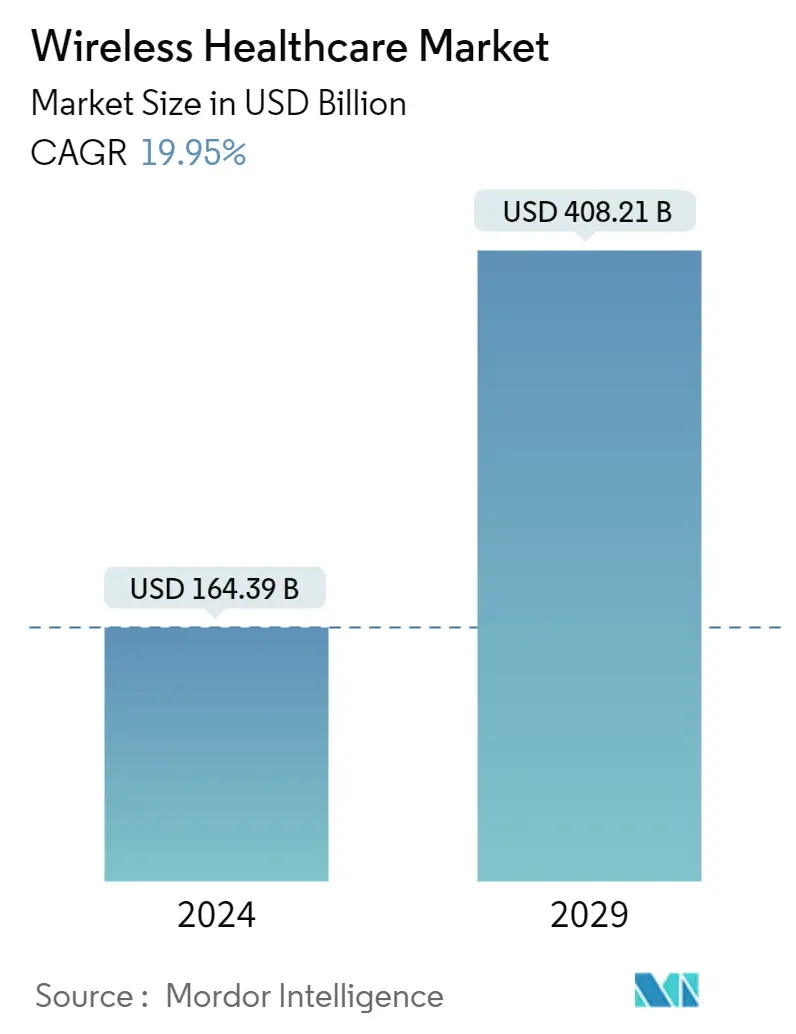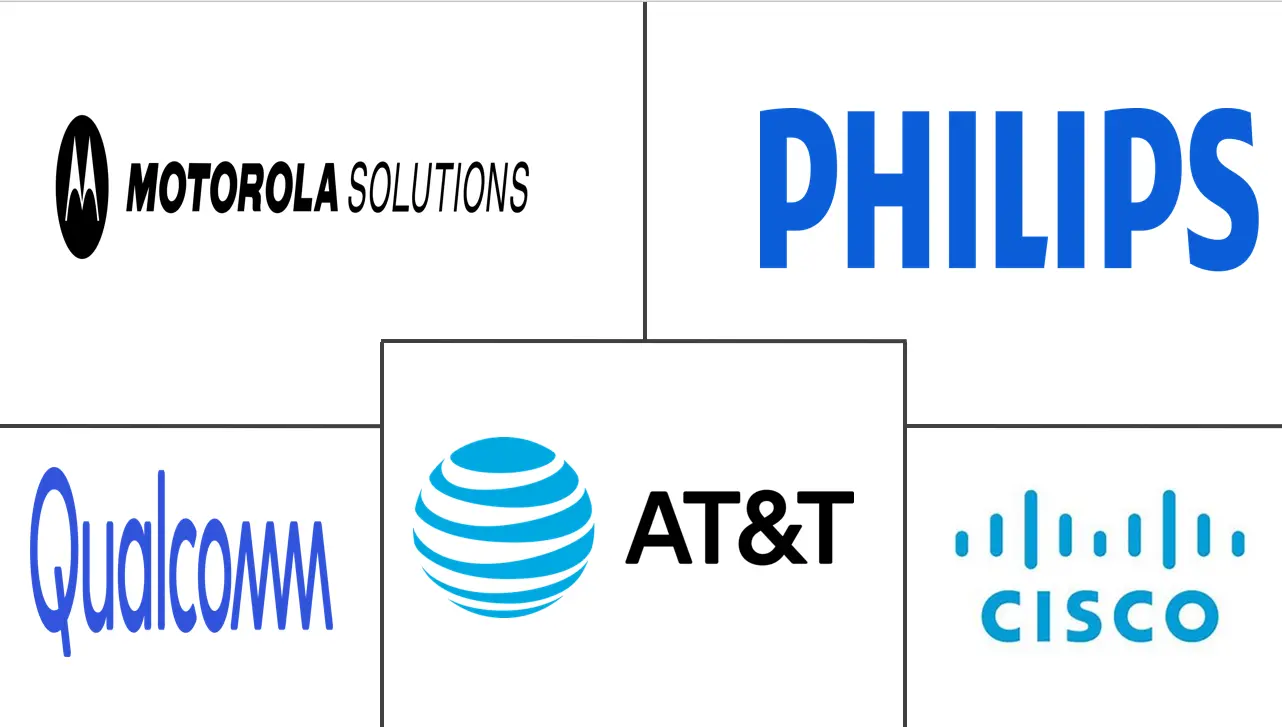Market Size of Wireless Healthcare Industry

| Study Period | 2019-2029 |
| Market Size (2024) | USD 164.39 Billion |
| Market Size (2029) | USD 408.21 Billion |
| CAGR (2024 - 2029) | 19.95 % |
| Fastest Growing Market | Asia-Pacific |
| Largest Market | North America |
| Market Concentration | Low |
Major Players
*Disclaimer: Major Players sorted in no particular order |
Wireless Healthcare Market Analysis
The Wireless Healthcare Market size is estimated at USD 164.39 billion in 2024, and is expected to reach USD 408.21 billion by 2029, growing at a CAGR of 19.95% during the forecast period (2024-2029).
The wireless healthcare market is major driven by increasing digitization, growth in the use of connected devices, advancements in wireless technology, and rising adoption of patient-centric approaches by healthcare organizations coupled with growing demand for quality healthcare.
- The healthcare sector worldwide has rapidly undergone a significant digital transformation over the past few years. The penetration of the internet and wireless communication technology is driving the market studied. In a connected hospital, caregivers use wireless medical equipment to provide patients with quality care rather than being preoccupied with time-consuming administrative tasks. Doctors and nurses can easily access up-to-date patient information, enabling treatment decisions supported by real-time medical information, thus, resulting in improved outcomes for patients.
- Wearable devices for continuous monitoring are driving the market. Owing to the proliferation of smartphones and the acceptance of wearable devices, medical devices and diagnostic centres are experimenting with body-worn sensors that can monitor vital signs and transmit them in real time to an online platform that can be remotely accessed.
- Further, the adoption of wearable devices in this sector has been gaining traction in recent times, which, in turn, has been one of the significant factors influencing the wireless healthcare market. The major trends in wearable connected devices include increasing demand for pain management wearable devices, increasing use of wearables for cardiovascular disease management, and others.
- Moreover, the growing demand for remote patient monitoring solutions due to the aging population and long-term chronic disease conditions is the major factor impacting the market's growth. There is constant pressure on hospital administrators to lower costs while continuing to improve the level of patient care. In this environment, hospitals use wireless technologies to operate more efficiently, support patient care, and improve their experience.
- For instance, to better understand and improve the workflow of nursing staff, hospitals are equipping nurse ID badges with an RFID tag that works with the hospital's Wi-Fi network. These tags track the movement of the nurses throughout their shifts. The data is captured and analyzed, providing insights to the hospital to improve the processes. Wireless RFID technology also allows hospitals to track the real-time location of critical equipment and the condition of the equipment.
- However, issues about cybersecurity and privacy are restraining the market growth, as vast amounts of healthcare data are generated during treatment in medical centers, such as hospitals and clinics, and the theft of such data can damage patients' privacy.
- The outbreak of COVID-19 enabled the growth of the market studied. The need for social distancing supported the use of wireless technology in the healthcare industry. This enabled the deployment of remote monitoring and telemonitoring systems, which demanded wireless infrastructure deployment. Also, government health bodies were allowing healthcare facilities to expand their remote monitoring spectrum. For example, in March 2020, FDA cleared non-invasive vital sign measuring devices to expand their use to help healthcare providers to monitor patients remotely. Such initiatives had driven the market for wireless healthcare during the pandemic.
Wireless Healthcare Industry Segmentation
The wireless healthcare market is growing, as the increase in the global geriatric population level is leading to a rise in the number of patients visiting hospitals. The aforementioned factor is also the root cause of the demand for integrated and connected solutions in hospitals, nursing homes, and home care centers.
The wireless healthcare market is segmented by technology (wireless personal area network (WPAN), Wi-Fi, worldwide interoperability for microwave access (WiMAX), and wireless wide area network (WWAN)), component (hardware, software, and services), application (hospitals and nursing homes, home care, and pharmaceuticals), and geography (North America, Europe, Asia Pacific, Latin America, Middle East & Africa). The market sizes and forecasts are provided in terms of value (USD) for all the above segments.
| Technology | |
| Wireless Personal Area Network (WPAN) | |
| Wi-Fi | |
| Worldwide Interoperability for Microwave Access (WiMAX) | |
| Wireless Wide Area Network (WWAN) |
| Component | |
| Hardware | |
| Software | |
| Services |
| Application | |
| Hospitals and Nursing Homes | |
| Home Care | |
| Pharmaceuticals | |
| Other Applications |
| Geography | |
| North America | |
| Europe | |
| Asia-Pacific | |
| Latin America | |
| Middle East & Africa |
Wireless Healthcare Market Size Summary
The wireless healthcare market is experiencing robust growth, driven by the increasing digitization of healthcare services, the proliferation of connected devices, and advancements in wireless technology. This market transformation is largely fueled by the shift towards patient-centric approaches, which emphasize the delivery of quality healthcare. The integration of wireless communication technologies in healthcare settings, such as connected hospitals, enables healthcare professionals to access real-time patient information, thereby enhancing treatment outcomes. The rise of wearable devices for continuous monitoring further propels market expansion, as these devices facilitate the remote tracking of vital signs and health metrics, supporting the growing demand for remote patient monitoring solutions. Despite the promising growth trajectory, challenges related to cybersecurity and data privacy remain significant concerns, potentially hindering market progress.
Regionally, North America is poised to maintain a substantial share of the wireless healthcare market, supported by its advanced healthcare infrastructure, high healthcare expenditure, and proactive government initiatives aimed at digitizing the sector. The region's focus on enhancing patient care quality through digital transformation and the adoption of cutting-edge wireless technologies, such as Wi-Fi 6 and 6E, contributes to its market leadership. Key industry players, including AT&T Inc., Cisco Systems Inc., and Motorola Solutions Inc., are actively expanding their market presence through strategic alliances and technological innovations. These companies are leveraging advanced connectivity solutions, such as 5G, to improve healthcare delivery and patient outcomes. The ongoing development and deployment of wireless healthcare solutions underscore the sector's commitment to enhancing efficiency, reducing costs, and improving access to critical medical information.
Wireless Healthcare Market Size - Table of Contents
-
1. MARKET INSIGHTS
-
1.1 Market Overview
-
1.2 Industry Attractiveness - Porter's Five Forces Analysis
-
1.2.1 Threat of New Entrants
-
1.2.2 Bargaining Power of Buyers/Consumers
-
1.2.3 Bargaining Power of Suppliers
-
1.2.4 Threat of Substitute Products
-
1.2.5 Intensity of Competitive Rivalry
-
-
1.3 Industry Value Chain Analysis
-
1.4 Assessment of the impact of COVID-19 on the Market
-
-
2. MARKET SEGMENTATION
-
2.1 Technology
-
2.1.1 Wireless Personal Area Network (WPAN)
-
2.1.2 Wi-Fi
-
2.1.3 Worldwide Interoperability for Microwave Access (WiMAX)
-
2.1.4 Wireless Wide Area Network (WWAN)
-
-
2.2 Component
-
2.2.1 Hardware
-
2.2.2 Software
-
2.2.3 Services
-
-
2.3 Application
-
2.3.1 Hospitals and Nursing Homes
-
2.3.2 Home Care
-
2.3.3 Pharmaceuticals
-
2.3.4 Other Applications
-
-
2.4 Geography
-
2.4.1 North America
-
2.4.2 Europe
-
2.4.3 Asia-Pacific
-
2.4.4 Latin America
-
2.4.5 Middle East & Africa
-
-
Wireless Healthcare Market Size FAQs
How big is the Wireless Healthcare Market?
The Wireless Healthcare Market size is expected to reach USD 164.39 billion in 2024 and grow at a CAGR of 19.95% to reach USD 408.21 billion by 2029.
What is the current Wireless Healthcare Market size?
In 2024, the Wireless Healthcare Market size is expected to reach USD 164.39 billion.

